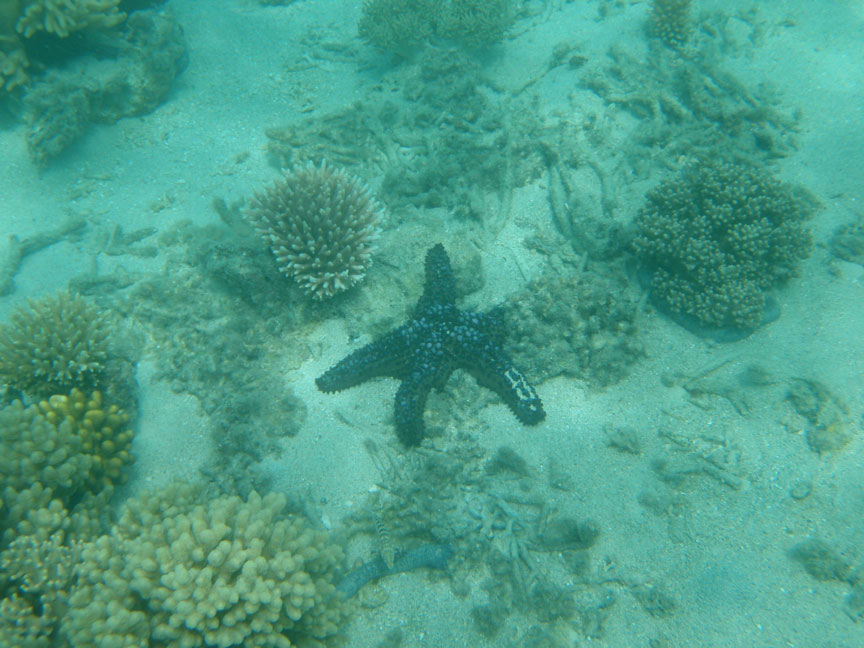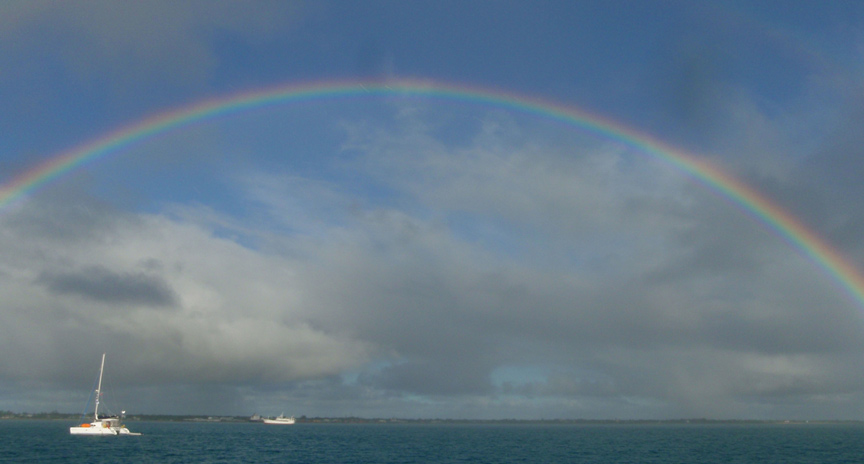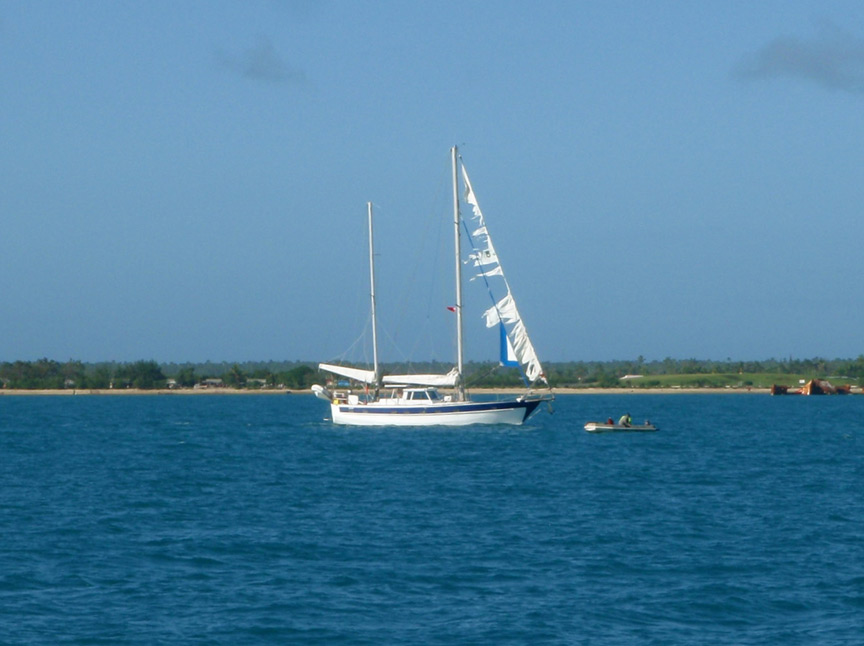Tongan Weather Adventures - Pangaimotu Island, Tongatapu, Tonga

Harmonie
Don and Anne Myers
Thu 4 Jun 2009 09:27
|
21:07.588S 175:09.819W
Tongan weather is known to be somewhat
unpredictable. The wind can change 180 degrees and whip up to a frenzy in
a matter of minutes, unleashing nasty storms with all those things a boater
hates - extremely high winds, pounding rain and above all, lightening.
Last year, in all of our travels, we ran into lightening only once in the
tropics, and that was during a four hour storm we hit while sailing from
the Tuamotus to Tahiti. Even then the lightening was far away and not
really a threat, which was good since the two tall masts on our
boat might look tempting to the odd bolt of lightening passing by. In
general, nasty storms and particularly thunder and lightening storms are rare in
the tropics. However, Tonga happens to sit in an area that is often on the
edge of what's called the South Pacific Convergence Zone (SPCZ). We
don't claim to understand all the particulars, but we do understand that the
result of two large air masses converging above our heads is often not
pretty. This meeting of air masses and potentially stormy weather
happens quite often in Tonga resulting in the general weather pattern which is
described in all the guide books as 'five days of settled weather and
consistent southeast trade winds followed by ten days of unsettled weather and
winds from every direction occasionally accompanied by storms'.
The good news is that with all the weather information available today via the
internet and long range radio, we usually know when unsettled weather is coming
- it's just a matter of how unsettled it will be. Even without the
internet and radio weather, a gander at the sky and some level of attention
to wind direction trends usually tells the story. Again, it's just a
matter of how bad the unsettled weather will be. If the wind direction is
predicted to move 180 degrees or even 360 degrees, then astute boaters will
make sure that the site they have chosen to anchor will still provide
shelter in all the expected wind directions. This isn't always easy
given that some island groups just don't have anchorages where shelter
is provided from more than one or two wind directions. In this case,
boaters do what we've done over the past two weeks, plan island hopping
travels through Tonga based on the weather forecasts. If we know a west
wind is coming and there is no nearby anchorage with protection from the west,
then we'll move on to an island and anchorage that does. If the
weather is severely changeable and we are in an anchorage with decent protection
from several wind directions, we'll wait out the unsettled weather and not
leave until the sun shines again and the wind swings back to the
southeast.
Our first encounter with unsettled Tongan weather
happened when we and the rest of the rally boats were still anchored off tiny
Pangaimotu Island. It was the day after the big pirate party and things
were mighty quiet until about noon when the wind started to pick up. At
this point, the wind was coming from the northeast and the island along with the
reef stretching off its coast sheltered the closely packed boats fairly
nicely. As the afternoon wore on, the wind increased as did the tension
aboard most of the anchored boats. We all knew a wind shift to the west
and high winds were coming, we just didn't know exactly when it would happen and
exactly how high the winds would go. We assured ourselves that the
wind shift would happen some time in the evening and the winds would only go as
high as 30 knots (~35 mph). The sun went down at six and the wind started
gusting consistently to 25 knots. Why is it, we often wonder, that the worst
weather always happens at night? And why does it happen when we are
anchored in an area where the water is 20 meters (~60 feet) deep? The rule
of thumb when anchoring is that the water depth to anchor line deployed
ratio should be at least 3 to 1 in very calm conditions and as much as 7 to 1 in
a wind storm. Unfortunately, when the water depth is 20 meters, a 7 to 1
ratio, or scope as it is called, would mean we'd have to deploy 140 meters (~420
feet) of anchor line. In an area where there are 20 boats tightly packed
and all at anchor, deploying 140 meters of anchor line is not possible for two
reasons; many boats don't carry that length of anchor line, and with so many
boats packed in a relatively tight space, boat collisions could easily happen as
all boats would be swinging around their anchors in very large arcs. In a
water depth of 20 meters at Pangaimotu Island, most boats, including
Harmonie, had about 80 meters of anchor chain or a combination of chain and
line out, which meant only a 4 to 1 scope at best.
Six-thirty arrived and the wind increased,
regularly gusting to 30 knots. We decided to postpone dinner until the
worst of the storm passed. Since we believed the worst of the storm would
be 30 knots, we figured we wouldn't have long to wait. Seven o'clock
arrived with higher winds - 35 knots. Shortly thereafter, the expected
wind shift from the northeast to the west happened. This was no gentle
breeze slowly making its way around the compass. Oh no, this was a mighty
shot of freight train wind that flipped immediately from northeast to northwest
in the space of a few seconds and at a speed of 47 knots (54 mph). The
mighty puff of wind in itself was bad enough, but the accompanying change
in direction in combination with boats with less than desirable anchor line
scope deployed on a sloping sea bottom resulted in immediate chaos for at least
six boats in the anchorage. Forget about dinner, we scrambled to turn on
all the instruments, the computer, electronic charts, the engine and the
lights as we squinted into the darkness through the sideways rain shouting
at each other over the roar of the wind about which boats were dragging,
where they were going and if we were in danger of getting hit. It was
about then, as the wind continued to gust into the high 40's that our anchor
alarm went off indicating that we were dragging. The feeling was
like being on one of those rides at the fair when you lose your stomach as
the contraption plummets in unexpected directions. When our anchor let go,
we could feel the movement and it was fast. I immediately fell into
military mode, asking for orders from the captain, 'Tell me what to do!' I
yelled. 'Motor forward! Don bellowed back. It was about then, after
our (mostly my) 30 seconds of panic that we realized the anchor had caught
again and was holding as the wind and rain continued to pummel us.
Later we realized we had dragged about 50 meters, half a football field,
in less than 15 seconds. For the next three and half hours,
Don was stationed at the wheel, with all instruments on and motor running while
I stood in the cabin watching all the instruments to be sure we weren't dragging
again. It felt and sounded like we were sailing. The boat was
bouncing up and over wind waves as they smashed on the bow and we were surfing
fast side-to-side as the anchor strained and the wind pushed hard.
Boats that dragged and continued dragging had
to pull up anchor, weave their way through the crowded anchorage between
boats wildly surfing side-to-side in the relentless wind, with zero visibility
in the pounding rain. Zero visibility except for the ever increasing
flashes of lightening that is. The next day Jackie from Lady Kay told
us she was incredibly grateful for the lightening as it gave her flashes
of visibility as she piloted Lady Kay through the anchorage
after she and Michael pulled up their own
dragging anchor.
After about three hours of this ordeal, with Don
still positioned at the helm and me still staring at the instruments, a new
threat emerged. In between lightening flashes, Don noticed a very
large vessel leaving the Nuku'alofa harbor and heading straight for Pangaimotu
Island and our chaotic anchorage. Several other boats noticed the same
thing and immediately got on the radio warning the large vessel off. For
about an hour various boats tried calling what looked like a dilapidated Tongan
ferry boat on the radio to ask them to leave the anchorage, but to no
avail. The Tongan ship never responded to the radio calls and took up
residence in the roaring wind and rain perilously close to several of us
that were located on the outskirts of the anchorage. The wind
continued to howl and we worried not only about wayward sailboats grazing by us,
but now the possibility of a giant ferry boat grazing by us as
well. Ten thirty arrived and the wind finally backed off to less than 35
knots, but the rain and lightening continued. We decided it was finally
safe to eat dinner and scarfed down a quick sandwich while continuing our
stationary watch. A little later, the wind backed down below 30 and Don
left his post for bed. As per usual in this kind of situation, I was too
jumpy to sleep and stayed up the rest of the night watching and waiting for the
wind to dissipate even further. At seven in the morning the wind
relented and dropped below fifteen knots. Time for
sleep.
The next day I asked Don what he would have done
differently had he known the wind was going to be as ferocious as it was.
He said he would have put out more anchor line and had two of our largest
fenders (dock bumpers) ready at the bow such that if we dragged and didn't stop
he could have simply cut the anchor line, tied the fenders to the severed end,
and instructed me to motor us out of the anchorage leaving the anchor behind for
retrieval the next day after the storm passed. He figured this would have
been the quickest way to get out of the anchorage without hitting another
boat. If we had to pull up the anchor, it would have taken too long and we
would have continued to drag into dangerous places during the process.
Next time we'll be more prepared.
Less than two months into our second sailing season
and we have already broken the highest wind while sailing record once and the
highest wind while anchored record twice. Hopefully that's it for record
breaking for a while.
On the bright side, we did have a few days of nice
weather during our stay at Pangaimotu Island. Good enough to go snorkeling
and try out our new underwater camera. Picture 1 is one of the gigantic
blue/black starfish that are common in Tonga. Picture 2 is the coral reef near
the island with a few tropical fish tooling around including our favorite tiny
iridescent blue variety. A few days after the big storm we were greeted by
the incredible full rainbow in picture 3. Unfortunately I couldn't quite
get the whole thing in the frame, but it was the most beautiful rainbow we have
ever seen. Both ends went straight down into the water and were reflected
there so that the rainbow continued on over the water's surface.
Amazing.
Picture 4 is the sailboat that arrived in Tonga
from New Zealand a few days after we did. Obviously they encountered some
of that famously ugly New Zealand weather along the way, which decimated
their head sail. The typical response when the rest of us sailboaters see
a sight like this is, 'Wow. Glad it wasn't us.' Not too sympathetic,
but indeed, perfectly honest. To add insult to injury, this boat's anchor
got hooked on an old ship's anchor and chain lying on the bottom and they were
unable to haul their anchor until divers helped them disentangle it. The
good news is that they were hooked on the old ship's anchor and chain throughout
the big storm and didn't drag. Like all things in life, there's usually a
bright side. It's just that some bright sides take a little more effort to
find than others. We didn't talk to the people on this boat, but can only
guess that they weren't necessarily ready to admit there was a bright side just
yet.
Anne
|



